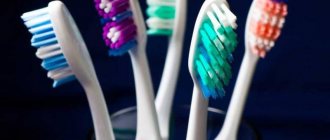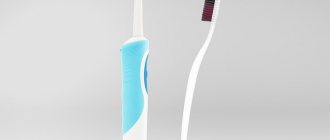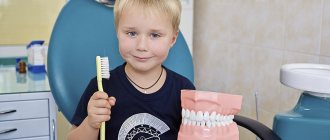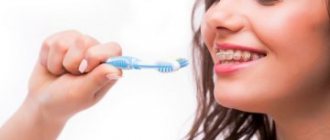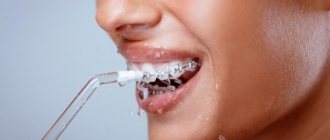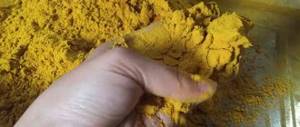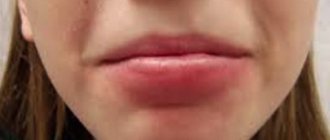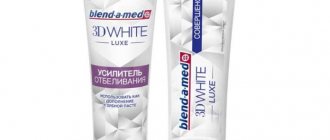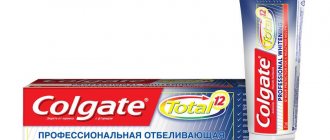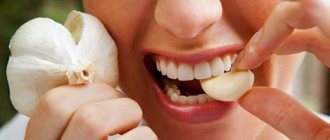The method of Leonard, Charter, Stillman, Smith-Bell, Reite, Fones, Bass - do these names tell you something? Most likely not, although the above are just different techniques for brushing your teeth. A specific technique can be recommended by a dentist after a thorough examination of the patient’s oral cavity. For example, for gum inflammation in adolescence, it is recommended to use gentle techniques, which include the Charter and Bass methods. Let's try to figure out what the features of each approach are.
Consequences of improper teeth brushing
It may surprise some, but improper brushing not only does not get rid of plaque, but can also lead to deterioration of the condition of teeth and gums. Surprising, but nevertheless, it is a fact.
The most common mistake when using a classic (manual) brush is brushing your teeth only with horizontal movements (right - left). With this method:
- the interdental spaces are not cleaned, becoming additionally clogged with plaque;
- Plaque near the gums is not removed, forming large accumulations of dirt and pathogenic microflora.
The above leads to problems such as:
- wedge-shaped defect (in its advanced form it can cause exposure of the neck and fracture of the dental crown);
- caries;
- periodontitis (inflammation of the tissues surrounding the teeth);
- inflammatory processes, bleeding gums;
- formation of tartar;
- pronounced darkening of the enamel;
- bad breath, etc.
Even when using high-quality toothpastes and brushes, the best preventative measure for the mentioned dental problems is still choosing and following the correct teeth brushing technique.
Professional teeth cleaning
Daily brushing of teeth, even if you follow all the rules described above, is not a 100% guarantee of removing plaque deposits from the entire oral cavity. As a rule, pathogenic microflora remains in hard-to-reach areas (between the back teeth, on the upper teeth, in subgingival pockets, etc.), which can gradually develop into tartar and lead to the development of caries or gum inflammation.
To avoid such consequences, dentists advise visiting a specialist every 6 months for comprehensive professional cleaning, which can be performed manually or using a machine. At the same time, the hardware method has an undoubted advantage - simultaneous polishing and whitening of tooth enamel.
The method of teeth cleaning in a dental clinic is selected individually, based on the wishes of the patient, the characteristics of the body and the possible presence of contraindications.
METHODS OF INDIVIDUAL TEETH CLEANING
Every professional dentist will confirm that simply brushing your teeth is not enough. They need to be cleaned correctly. And this is not such a simple science as it might seem at first glance. There are many “name” methods for owning a toothbrush: Mr. Charter, Stillman, Smith-Bell, Reite, Fones, Bass and Leonardo. They differ in the nature of movements, sequence and position of the brush relative to the teeth or gingival margin.
Once upon a time, each of the listed dentists defended the superiority of their method over others. Nowadays, all the many techniques can be reduced to a few general ones, recommended to achieve a particular effect. But, before moving on to their descriptions, let us recall several important principles, the observance of which will help you emerge victorious in the battle with caries.
1. Ideally, you should brush your teeth after every meal. And the minimum that you should accustom yourself to is a morning and evening procedure.
2. The entire process of brushing your teeth should take at least three minutes. To help you keep track of time, keep an hourglass in your bathroom.
3. Brush at the same pace and always start with the same row of teeth.
4. After brushing your teeth, be sure to wash the brush and place it in a glass with the bristles facing up. Do not store the brush in a case, because it must dry out!
Finally, let's move on to specific methods of brushing teeth that are suitable for both adults and children.
Method one – “Universal”
— Positioning the brush at an angle of 45 degrees to the surface of the tooth, make 10 movements from the gum down to the cutting edge. Repeat on each two-tooth section.
- Brush the inside surface of your chewing teeth in the same way.
— To clean the inside of your front teeth, hold the brush perpendicular to the cutting edges and move it forward only.
— Brush the chewing surfaces of all teeth using movements from front to back.
- Brush the teeth of the lower jaw in the same order.
- Finish the cleaning with a gum massage. To do this, close your mouth and make circular movements with the brush, grabbing your teeth and gums. Massage is contraindicated if you have areas of inflammation on your gums or oral mucosa.
Method two – “Gentle”
— Place the toothbrush perpendicular to the surface of the teeth. Make vertical movements in the direction from the gum to the cutting edge.
- With your teeth closed, brush their cheek surfaces using back and forth movements of the brush. Open your mouth and brush your teeth from the inside in the same way. This method avoids damage to the gums.
Method three – “Healthy gums”
— Close your teeth, position the brush perpendicular to the cheek surface of your teeth and perform circular movements.
— Open your mouth and brush the inner and chewing surfaces of your teeth in a circular motion: first on the upper jaw and then on the lower jaw. This method can only be used by those who do not have periodontal disease.
By the way, another interesting point. How much toothpaste do you squeeze onto your brush? For regular paste (and even more so for medicinal paste!) you should take about the size of a pea. Moreover, you can brush your teeth efficiently without it at all. But you can’t do this without a good brush. So choose it carefully, change it often and be healthy!
Classical technique of brushing teeth (Pakhomov G.N. method)
Most Russian dentists recommend the method of brushing teeth, invented by professor of dentistry Gennady Nikolaevich Pakhomov.
Pakhomov's method G.N. is considered the most effective and consists of the following algorithm of actions:
- The dentition should be divided into 4 segments (left and right parts of the upper jaw, left and right parts of the lower jaw).
- It is advisable to start cleaning from the upper jaw from the right molars towards the front teeth. Next, brushing along the top row continues from the front teeth and ends on the left molars.
- The lower jaw is cleaned, on the contrary, from the left molars to the front ones and ends at the right molars.
- When cleaning the outer and inner surfaces of the dentition, the brush must be held horizontally. The bristles should be positioned at a 45° angle to the surface of the teeth and gums. Cleaning is carried out with sweeping movements from the gums to the edge of the tooth. For each pair of teeth, 10 such movements must be performed.
- Contaminants from the chewing side of the teeth are removed by moving the brush head back and forth (reciprocating movements). At the same time, the fibers of the brush penetrate deeply into the interdental spaces and fissures, providing high-quality cleansing.
- To clean the inner surface of the front teeth, it is more convenient to place the brush vertically. Cleaning is also carried out using sweeping movements from the gums to the edge of the tooth.
Standard method of Pokhomov G.N. allows you to thoroughly clean the oral cavity. If there are hard-to-reach areas of the dentition that are inaccessible to the toothbrush used, then it is recommended to use additional means - dental floss, irrigators, etc.
German scientists compared different methods of brushing teeth
Most people brush their teeth regularly, but they do not realize that oral health depends not only on frequency, but also on proper brushing technique. In a recent study, German scientists compared two common methods of brushing teeth to determine which was easier and more effective.
Photo © www.liveinternet.ru
In a study conducted at the University of Hesse, scientists compared the results of two different toothbrushing techniques - the Fones and Bass methods - to determine their effectiveness.
The method developed by Alfred C. Fones is the most commonly used and is generally recommended in oral hygiene brochures. Its essence: the toothbrush is located at a right angle to the vestibular surface of the teeth, the dentition is closed, the hand makes circular movements. The palatal and lingual surfaces of the teeth are cleaned with the same brush movements with the mouth open. The chewing surfaces of the teeth are cleaned in the anteroposterior direction.
The brushing technique pioneered by Dr. Charles C. Bass is also often recommended by dentists and described in textbooks. This method allows you to efficiently remove food debris and plaque in the cervical area. In this case, the head of the toothbrush is located at an angle of 45º to the axis of the tooth, the tips of the bristles are located at the edge of the gum and, with light pressure, penetrate the gingival sulcus. The hand makes short back-and-forth movements. Vertical movements of the brush are used to clean the front teeth.
The study involved 67 university students who had bleeding gums in the area of 10 or more teeth during examination. All subjects did not study in the specialty “Dentistry”, did not smoke and used a regular manual toothbrush.
Participants were randomized into groups, one of which was trained in brushing using the Fones method, the other in the Bass technique. The control group was introduced to the standard method of brushing teeth. Students were given only one hands-on demonstration of the technique, but were able to view PowerPoint presentations with verbal explanations and pictures of the toothbrushing technique of interest without restriction as needed.
At the end of the training, each study participant received a booklet demonstrating the main points of the presentations. In addition, they were given the same toothbrushes, toothpaste and floss for use at home.
Participants were assessed at 6, 12 and 28 weeks. According to most researchers, significant differences in the PBI index (Mulleman-Saxer interdental papilla bleeding index, Papilla Bleeding Index) were observed at week 28, and differences in the gingivitis index (Marginal Plaque Index, MPI) values in the area of the tooth neck were identified at all periods of the examination: after 6, 12 and 28 weeks. For the contact surfaces of the teeth, a significant difference was observed after 6 and 12 weeks.
The researchers were surprised by the relatively low effectiveness of the Bass method in the subjects, while those students who mastered the Fones method had a clear improvement in oral hygiene scores and a decrease in gingivitis symptoms. In addition, students learned faster using the Fones method.
The researchers suggested that one reason for this result was that the Fones method is the most well-known brushing technique in Germany, where the study was conducted, and was therefore easier for students to remember after just one training session.
According to the researchers, studies of the comparative effectiveness of tooth brushing methods should be continued with the participation of subjects of different age groups and different levels of education.
Based on materials from https://www.dental-tribune.com.
Rules for daily brushing of teeth
There are several basic methods for brushing your teeth yourself, so everyone can choose the right method for themselves. Dentists recommend Pakhomov’s technique, which has been known for a long time and is used in dental clinics when teaching children oral hygiene.
Rules of Professor Pakhomov's methodology.
- Cleaning begins from the upper row of teeth in the direction from the molars to the front teeth, from the right to the central teeth and similarly to the left.
- Continue cleaning on the lower dentition from the left molars to the front teeth and then to the right back teeth.
- The brush is held so that the head is at an angle of 45° relative to the gum.
- You need to clean your back teeth using “sweeping” movements from bottom to top.
- Chewing teeth are cleaned by moving the brush back and forth.
- The front teeth are brushed using “sweeping” movements with the brush positioned vertically.
- To clean the front teeth, the brush is placed vertically and moved in a sweeping motion.
- Each tooth must be cleaned separately, with at least 10 movements performed.
- The duration of the procedure is at least three minutes.
Dentists confirm that Professor Pakhomov’s teeth cleaning method allows for the proper cleaning effect of the entire surface of the teeth. But to remove deposits and food debris in the interdental spaces, special threads or irrigators should be used, and it is also recommended to use a tongue scraper for oral hygiene.
Additional methods of brushing teeth with a manual brush
The following two assistive techniques for brushing teeth are the most common:
Bass method
The peculiarity of this method is that it is suitable for cleaning teeth with open (exposed) root areas. The method provides not only cleaning of the teeth, but also massage of the gums.
The implementation of this technique provides for the following rules:
- The toothbrush must be held horizontally, at an angle of 45° to the surface of the tooth. In this case, half of the fibers of the toothbrush should extend beyond the gums.
- Cleaning is carried out first in a circular motion, then sweeping (from the gum to the edge of the tooth).
- To clean the internal surfaces and back (molars) teeth, the position of the brush changes to vertical.
- Cleaning the oral (palatal) and vestibular (external, from the lips and cheeks) surfaces of the tooth is performed with vibrating movements without moving the ends of the bristles.
- Chewing surfaces are cleaned with horizontal back-and-forth movements.
It is important to note that you should only use a soft toothbrush for this method.
Standard method of brushing teeth
The dentition is conventionally divided into several segments: large molars, small molars and anterior teeth on each side. (it turns out 4-6 segments). Teeth brushing is carried out with open dentition. The toothbrush is placed at an angle of 45 degrees to the surface of the tooth.
They begin to brush their teeth from the buccal surface of the upper jaw on the left (segment 1), where they perform 10 sweeping movements with the brush, after which they gradually move through all other segments, making 10 movements for each segment.
Next, they clean the palatal surface of the upper teeth, passing through the segments from left to right, making 10 sweeping movements on each segment.
The next stage of teeth cleaning is cleaning the chewing surface of the large and small molars. Cleaning is carried out with horizontal movements along their chewing surface. It is necessary to make 10-15 movements on each side.
On the lower jaw, teeth are brushed in the same sequence. First on the buccal, and then on the lingual and finally on the chewing surface of the teeth.
When cleaning the palatal surface of the upper incisors and the lingual surface of the lower teeth, the brush is positioned perpendicular to the dentition. The cleaning procedure should end with a massage of the gums, which is carried out with closed dentition using circular movements of the brush, capturing the teeth and gums of all segments.
